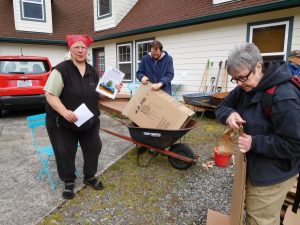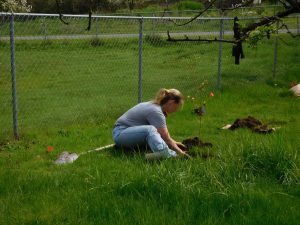This week I put on a fruit tree care workshop with Edible Forest Gardens and The Olympia Fruit Tree Project. Someone we met at an interest meeting for the Fruit Tree Project offered their yard as a site for our workshop. There were 15 trees on the property: apple, pear, and cherry, all around the age of 50 years.
The goal of the workshop was to improve the health of the ecosystem and the trees, specifically through fertile mulching, a method of tree care designed by Gary Kline of Black Lake Organics.
In the days before the workshop, we went to our nursery to pick out the bushes and trees for the workshop, to plant among the existing trees to make it into a guild, and brought them to the site, along with fencing and t-posts from urban farm and garden and tractor supply. The fences are to protect the Aronia berry bushes, a favorite of northwest deer.
We also did some work on projects at other places. We brought about 20+ trees from the nursery to Reeves middle school for a planting next week, and some trees and welded fence rolls to capitol vision community gardens. We spent the day on Friday making fences around all of the young trees that we planted on earth day (The space where we are putting the food forest is next to a dog park, and the young trees were getting knocked over and broken by dogs chasing balls)! We fenced off all of the front row of the trees and bushes, and replaced the dead trees with others.
Fertile Mulching Workshop
10 people showed up excited to learn new ways of giving to plants. We mixed “witches brew”, one part apple cider vinegar (for the microbes), one part molasses (for the microbes), one part liquid fish (macronutrients) and one part liquid kelp (essential minerals). Then we spread a cupful of tree-and-shrub mineral mix per tree. This mix includes rock phosphate, langbeinite, calcitic lime, kelpmeal, sulfate of potash, glacial rock dust, Azomite, volcanic rock dust, lignite, copper sulfate, zinc sulfate, and manganese sulfate. Unless we are growing edible native plants, adding minerals to northwest soil is just something we have to do if we want our food to be worth eating (the way around this is using biochar to attract and hold nutrients from being washed out).Then we put down three layers of cardboard around each tree and six inches of woodchips on top of the cardboard. This is substrate for the fungi which are needed to mobilize much of the minerals for uptake by the roots of the trees. We brought in some berry bushes and trees that attract pollinators and planted them in between the trees (currants, service berries, elder, aronia, Rosa rugosa). We also fertile mulched the berry bushes.
This is a picture of part of the site at the end of the workshop.
We will come back to sheet mulching the whole area when we have collected enough cardboard and when more wood chips are dropped off. Then we will bring in perennial vegetables and a mix of plants that accumulate minerals, repel weeds and pests, and attract beneficial insects.






Leave a Reply